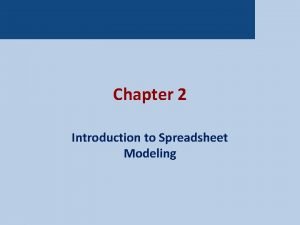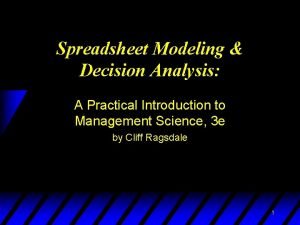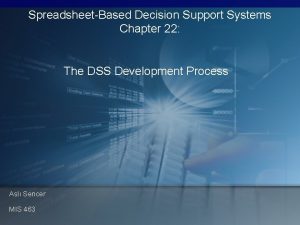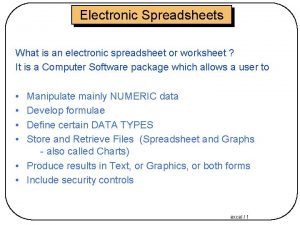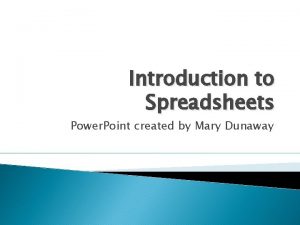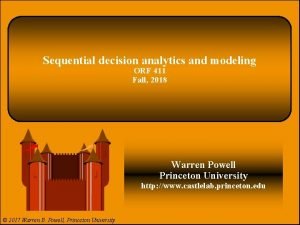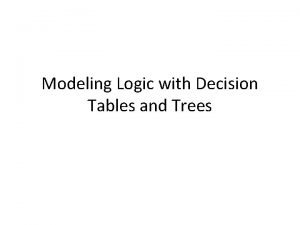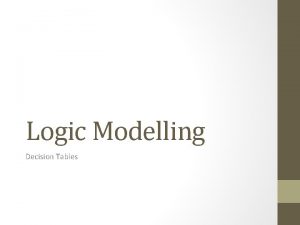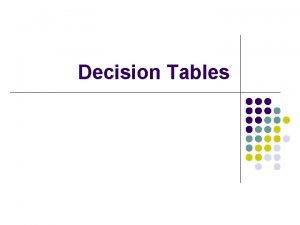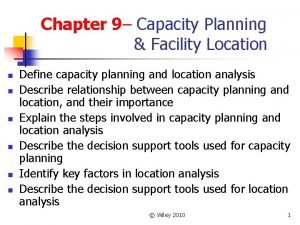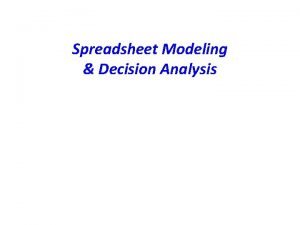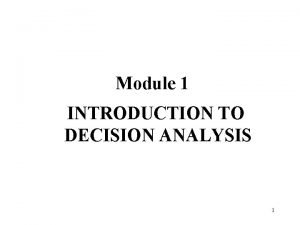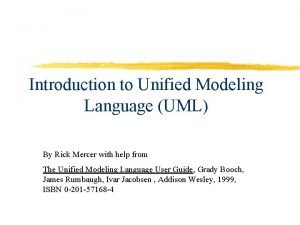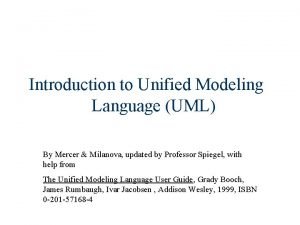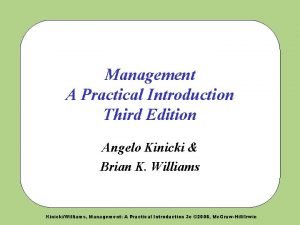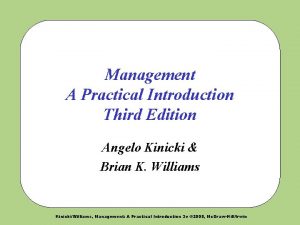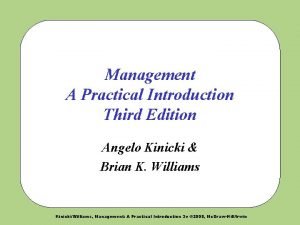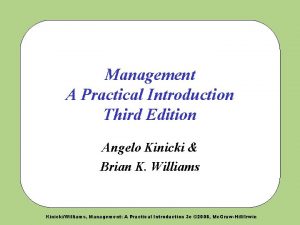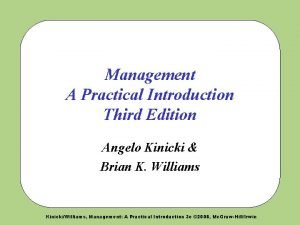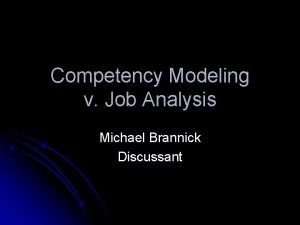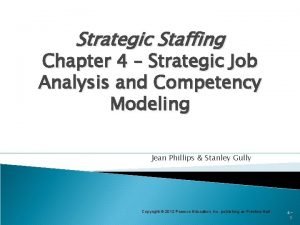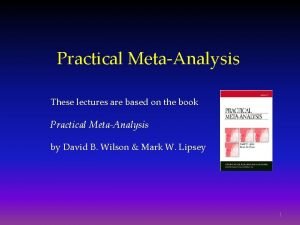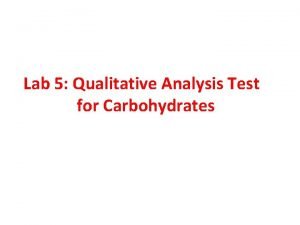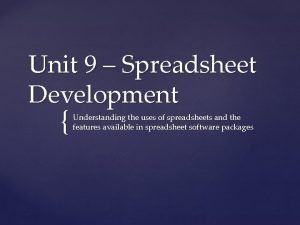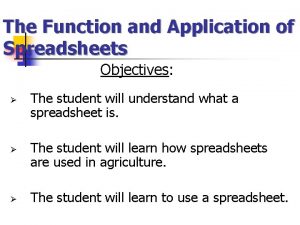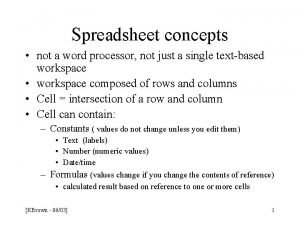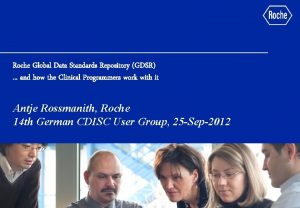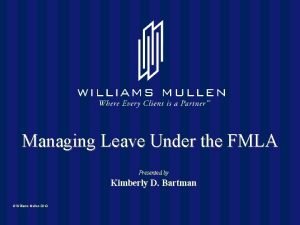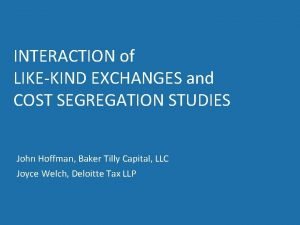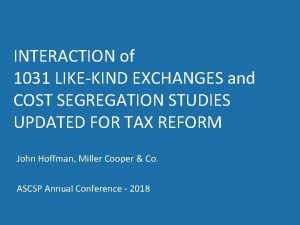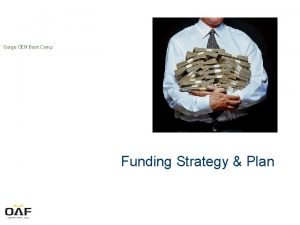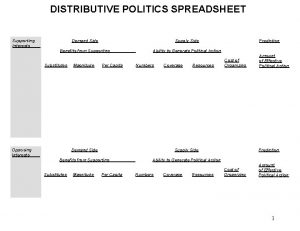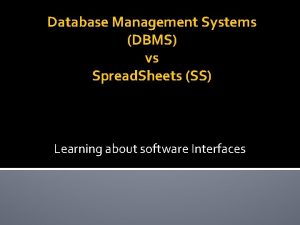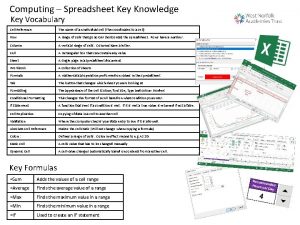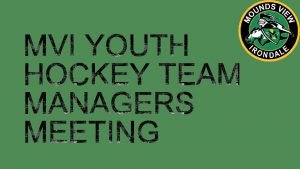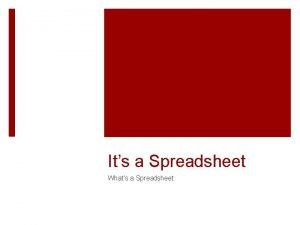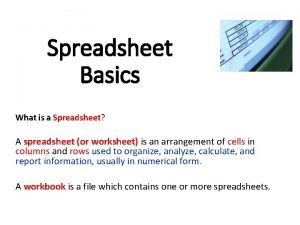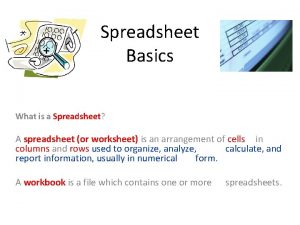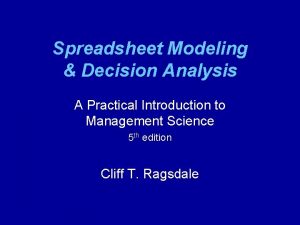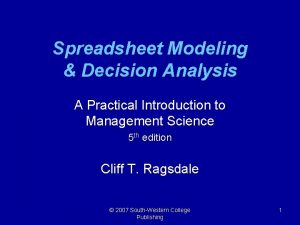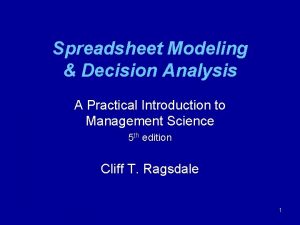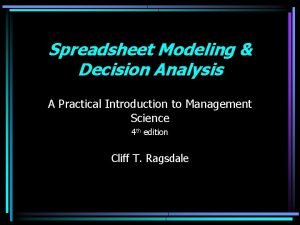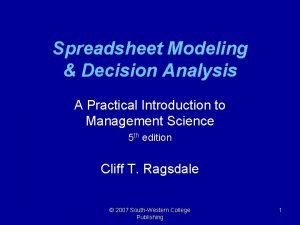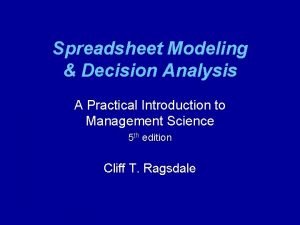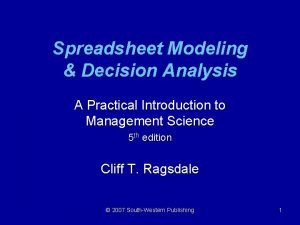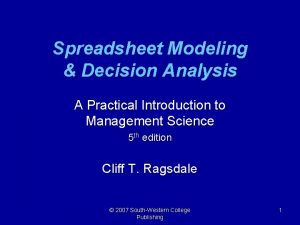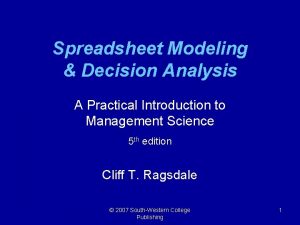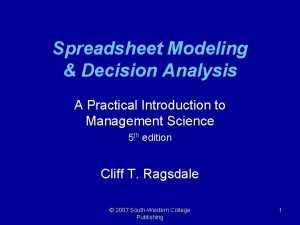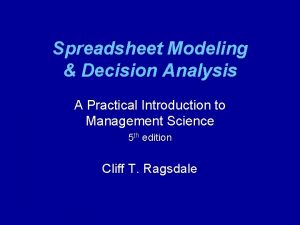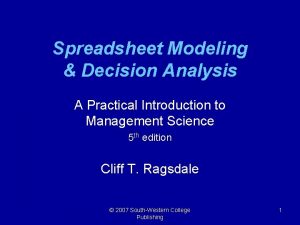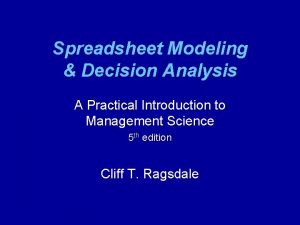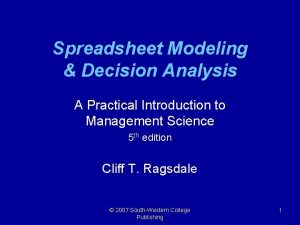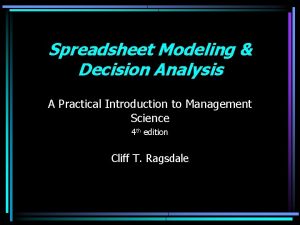Spreadsheet Modeling Decision Analysis A Practical Introduction to



















































- Slides: 51

Spreadsheet Modeling & Decision Analysis A Practical Introduction to Management Science 5 th edition Cliff T. Ragsdale

© 2007 South-Western College Publishing 2

Chapter 5 Network Modeling

Introduction § A number of business problems can be represented graphically as networks. § This chapter focuses on several such problems: – – – Transshipment Problems Shortest Path Problems Maximal Flow Problems Transportation/Assignment Problems Generalized Network Flow Problems The Minimum Spanning Tree Problem

Network Flow Problem Characteristics § Network flow problems can be represented as a collection of nodes connected by arcs. § There are three types of nodes: – Supply – Demand – Transshipment § We’ll use negative numbers to represent supplies and positive numbers to represent demand.

A Transshipment Problem: The Bavarian Motor Company +100 Boston 2 $50 +60 $30 Newark 1 -200 Columbus $40 3 $40 $35 +170 Atlanta 5 $30 Richmond +80 4 $25 $45 $35 +70 Mobile 6 $50 J'ville 7 -300

Defining the Decision Variables For each arc in a network flow model we define a decision variable as: Xij = the amount being shipped (or flowing) from node i to node j For example… X 12 = the # of cars shipped from node 1 (Newark) to node 2 (Boston) X 56 = the # of cars shipped from node 5 (Atlanta) to node 6 (Mobile) Note: The number of arcs determines the number of variables!

Defining the Objective Function Minimize total shipping costs. MIN: 30 X 12 + 40 X 14 + 50 X 23 + 35 X 35 +40 X 53 + 30 X 54 + 35 X 56 + 25 X 65 + 50 X 74 + 45 X 75 + 50 X 76

Constraints for Network Flow Problems: The Balance-of-Flow Rules For Minimum Cost Network Flow Problems Where: Apply This Balance-of-Flow Rule At Each Node: Total Supply > Total Demand Inflow-Outflow >= Supply or Demand Total Supply < Total Demand Inflow-Outflow <=Supply or Demand Total Supply = Total Demand Inflow-Outflow = Supply or Demand

Defining the Constraints § In the BMC problem: Total Supply = 500 cars Total Demand = 480 cars (Supply >= Demand) § For each node we need a constraint like this: Inflow - Outflow >= Supply or Demand § Constraint for node 1: –X 12 – X 14 >= – 200 § This is equivalent to: +X 12 + X 14 <= 200 (Note: there is no inflow for node 1!)

Defining the Constraints § Flow constraints –X 12 – X 14 >= – 200 +X 12 – X 23 >= +100 +X 23 + X 53 – X 35 >= +60 + X 14 + X 54 + X 74 >= +80 + X 35 + X 65 + X 75 – X 53 – X 54 – X 56 >= +170 + X 56 + X 76 – X 65 >= +70 –X 74 – X 75 – X 76 >= – 300 § Nonnegativity conditions Xij >= 0 for all ij } node 1 } node 2 } node 3 } node 4 } node 5 } node 6 } node 7

Implementing the Model See file Fig 5 -2. xls

Optimal Solution to the BMC Problem +100 Boston 2 $50 Newark 1 120 20 +60 $30 Columbus 80 3 -200 $40 40 +170 Richmond +80 4 Atlanta 5 $45 +70 Mobile 6 210 70 $50 J'ville 7 -300

The Shortest Path Problem § Many decision problems boil down to determining the shortest (or least costly) route or path through a network. – Ex. Emergency Vehicle Routing § This is a special case of a transshipment problem where: – There is one supply node with a supply of -1 – There is one demand node with a demand of +1 – All other nodes have supply/demand of +0

The American Car Association +0 L'burg 9 11 2. 0 hrs 9 pts 1. 7 hrs 5 pts +0 -1 2. 8 hrs 7 pts +0 3. 0 hrs 4 pts A'ville 6 Chatt. 3 G'boro 1. 5 hrs 3 pts +0 Charl. 7 2. 0 hrs 8 pts Atlanta 2. 5 hrs 3 pts 1. 5 hrs 2 pts G'ville 4 2. 5 hrs 3 pts 2 +0 +0 1. 1 hrs 3 pts 8 1. 7 hrs 4 pts 3. 0 hrs 4 pts B'ham 1 2. 0 hrs 4 pts 4. 7 hrs 9 pts K'ville 5 +1 Va Bch 5. 0 hrs 9 pts +0 3. 3 hrs 5 pts 2. 7 hrs 4 pts Raliegh 10 2. 3 hrs 3 pts +0 +0

Solving the Problem § There are two possible objectives for this problem – Finding the quickest route (minimizing travel time) – Finding the most scenic route (maximizing the scenic rating points) See file Fig 5 -7. xls

The Equipment Replacement Problem § The problem of determining when to replace equipment is another common business problem. § It can also be modeled as a shortest path problem…

The Compu-Train Company § Compu-Train provides hands-on software training. § Computers must be replaced at least every two years. § Two lease contracts are being considered: – Each requires $62, 000 initially – Contract 1: ØPrices increase 6% per year Ø 60% trade-in for 1 year old equipment Ø 15% trade-in for 2 year old equipment – Contract 2: ØPrices increase 2% per year Ø 30% trade-in for 1 year old equipment Ø 10% trade-in for 2 year old equipment

Network for Contract 1 +0 2 +0 $63, 985 4 $30, 231 $28, 520 $33, 968 $32, 045 -1 1 $60, 363 3 $67, 824 5 +1 +0 Cost of trading after 1 year: 1. 06*$62, 000 - 0. 6*$62, 000 = $28, 520 Cost of trading after 2 years: 1. 062*$62, 000 - 0. 15*$62, 000 = $60, 363 etc, etc….

Solving the Problem See file Fig 5 -12. xls

Transportation & Assignment Problems § Some network flow problems don’t have transshipment nodes; only supply and demand nodes. Supply 275, 000 400, 000 Groves Distances (in miles) 21 Mt. Dora 1 50 Processing Plants Capacity Ocala 4 200, 000 40 These problems are implemented more effectively using the technique 35 30 Eustis described in Chapter 3. Orlando 600, 000 2 5 22 55 300, 000 20 Clermont 3 25 Leesburg 6 225, 000

Generalized Network Flow Problems § In some problems, a gain or loss occurs in flows over arcs. – Examples ØOil or gas shipped through a leaky pipeline ØImperfections in raw materials entering a production process ØSpoilage of food items during transit ØTheft during transit ØInterest or dividends on investments § These problems require some modeling changes.

Coal Bank Hollow Recycling Process 1 Material Cost Newspaper $13 Mixed Paper $11 White Office Paper $9 Cardboard $13 Yield 90% 80% 95% 75% Newsprint Pulp Source Recycling Process 1 Recycling Process 2 Demand Cost Yield $5 95% $6 90% 60 tons Process 2 Cost $12 $13 $10 $14 Yield 85% 90% 85% Supply 70 tons 50 tons 30 tons 40 tons Packaging Paper Print Stock Cost Yield $6 90% $8 95% 40 tons Cost Yield $8 90% $7 95% 50 tons

Network for Recycling Problem -70 Newspaper $13 1 $12 -50 Mixed paper 2 -30 White office paper 3 $11 80% 5 75% $9 85% $10 90% -40 Cardboard 4 $14 85% Newsprint pulp +60 7 90% $6 $8 90% 95% 85% Packing paper pulp +40 Print stock pulp +50 8 $6 Recycling Process 2 6 $13 $5 Recycling Process 1 95% $13 95% +0 90% +0 $8 90% $7 95% 9

Defining the Objective Function Minimize total cost. MIN: 13 X 15 + 12 X 16 + 11 X 25 + 13 X 26 + 9 X 35+ 10 X 36 + 13 X 45 + 14 X 46 + 5 X 57 + 6 X 58 + 8 X 59 + 6 X 67 + 8 X 68 + 7 X 69

Defining the Constraints-I § Raw Materials -X 15 -X 16 >= -70 -X 25 -X 26 >= -50 -X 35 -X 36 >= -30 -X 45 -X 46 >= -40 } node 1 } node 2 } node 3 } node 4

Defining the Constraints-II § Recycling Processes +0. 9 X 15+0. 8 X 25+0. 95 X 35+0. 75 X 45 - X 57 - X 58 -X 59 >= 0 } node 5 +0. 85 X 16+0. 85 X 26+0. 9 X 36+0. 85 X 46 -X 67 -X 68 -X 69 >= 0 } node 6

Defining the Constraints-III § Paper Pulp +0. 95 X 57 + 0. 90 X 67 >= 60 } node 7 +0. 90 X 57 + 0. 95 X 67 >= 40 } node 8 +0. 90 X 57 + 0. 95 X 67 >= 50 } node 9

Implementing the Model See file Fig 5 -17. xls

Important Modeling Point § In generalized network flow problems, gains and/or losses associated with flows across each arc effectively increase and/or decrease the available supply. § This can make it difficult to tell if the total supply is adequate to meet the total demand. § When in doubt, it is best to assume the total supply is capable of satisfying the total demand use Solver to prove (or refute) this assumption.

The Maximal Flow Problem § In some network problems, the objective is to determine the maximum amount of flow that can occur through a network. § The arcs in these problems have upper and lower flow limits. § Examples – How much water can flow through a network of pipes? – How many cars can travel through a network of streets?

The Northwest Petroleum Company Pumping Station 3 Pumping Station 1 3 2 6 1 4 Oil Field Refinery 2 4 4 3 Pumping Station 2 5 5 Pumping Station 4 6

The Northwest Petroleum Company Pumping Station 3 Pumping Station 1 3 2 6 1 4 Oil Field Refinery 2 4 4 3 Pumping Station 2 5 5 Pumping Station 4 6

Formulation of the Max Flow Problem MAX: Subject to: X 61 +X 61 - X 12 - X 13 = 0 +X 12 - X 24 - X 25 = 0 +X 13 - X 34 - X 35 = 0 +X 24 + X 34 - X 46 = 0 +X 25 + X 35 - X 56 = 0 +X 46 + X 56 - X 61 = 0 with the following bounds on the decision variables: 0 <= X 12 <= 6 0 <= X 25 <= 2 0 <= X 46 <= 6 0 <= X 13 <= 4 0 <= X 34 <= 2 0 <= X 56 <= 4 0 <= X 24 <= 3 0 <= X 35 <= 5 0 <= X 61 <= inf

Implementing the Model See file Fig 5 -24. xls

Optimal Solution Pumping Station 1 3 3 2 5 2 6 Pumping Station 3 4 6 2 Oil Field 1 5 6 Refinery 2 4 4 3 Pumping Station 2 5 Pumping Station 4 4

Special Modeling Considerations: Flow Aggregation -100 1 2 $3 +0 3 $5 $4 $3 $4 $5 $5 4 $6 5 +75 6 +50 +0 Suppose the total flow into nodes 3 & 4 must be at least 50 and 60, respectively. How would you model this?

Special Modeling Considerations: Flow Aggregation -100 1 $3 +0 30 $4 +0 L. B. =50 3 2 $5 5 +75 6 +50 $3 $4 -100 $5 $5 40 +0 L. B. =60 4 $6 +0 Nodes 30 & 40 aggregate the total flow into nodes 3 & 4, respectively.

Special Modeling Considerations: Multiple Arcs Between Nodes $8 -75 1 $6 2 +50 U. B. = 35 Two two (or more) arcs cannot share the same beginning and ending nodes. Instead, try. . . +0 10 $0 -75 1 $8 $6 U. B. = 35 2 +50

Special Modeling Considerations: Capacity Restrictions on Total Supply -100 +75 $5, UB=40 1 3 $4, UB=30 $6, UB=35 2 -100 $3, UB=35 4 +80 Supply exceeds demand, but the upper bounds prevent the demand from being met.

Special Modeling Considerations: Capacity Restrictions on Total Supply -100 $999, UB=100 +200 +75 $5, UB=40 1 3 $4, UB=30 0 $6, UB=35 $999, UB=100 -100 2 $3, UB=35 4 +80 Now demand exceeds supply. As much “real” demand as possible will be met in the least costly way.

The Minimal Spanning Tree Problem § For a network with n nodes, a spanning tree is a set of n-1 arcs that connects all the nodes and contains no loops. § The minimal spanning tree problem involves determining the set of arcs that connects all the nodes at minimum cost.

Minimal Spanning Tree Example: Windstar Aerospace Company $150 2 $100 4 $85 $75 $40 1 $85 $80 5 $90 3 $50 $65 6 Nodes represent computers in a local area network.

The Minimal Spanning Tree Algorithm 1. Select any node. Call this the current subnetwork. 2. Add to the current subnetwork the cheapest arc that connects any node within the current subnetwork to any node not in the current subnetwork. (Ties for the cheapest arc can be broken arbitrarily. ) Call this the current subnetwork. 3. If all the nodes are in the subnetwork, stop; this is the optimal solution. Otherwise, return to step 2.

Solving the Example Problem - 1 4 2 $100 $85 1 $85 $80 $90 3 6 5

Solving the Example Problem - 2 4 2 $100 $85 1 $85 $75 $80 5 $90 3 $50 6

Solving the Example Problem - 3 4 2 $100 $85 1 $75 $80 5 $85 3 $50 $65 6

Solving the Example Problem - 4 4 2 $100 $85 $75 $40 1 $80 3 5 $50 $65 6

Solving the Example Problem - 5 $150 2 4 $85 $75 $40 1 $80 3 5 $50 $65 6

Solving the Example Problem - 6 4 2 $75 $40 1 $80 3 5 $50 $65 6

End of Chapter 5
 What is a spreadsheet model
What is a spreadsheet model Cliff ragsdale spreadsheet modeling solutions
Cliff ragsdale spreadsheet modeling solutions Objectives of decision making
Objectives of decision making Financial decision
Financial decision Developing spreadsheet-based decision support systems
Developing spreadsheet-based decision support systems Model and role modeling theory
Model and role modeling theory Relational vs dimensional data modeling
Relational vs dimensional data modeling Introduction to electronic spreadsheet
Introduction to electronic spreadsheet Introduction to spreadsheet ppt
Introduction to spreadsheet ppt Sequential decision analytics
Sequential decision analytics Decision logic table
Decision logic table Jan vanthienen
Jan vanthienen Modeling logic with decision tables
Modeling logic with decision tables Explain the decision tree modeling for capacity expansion
Explain the decision tree modeling for capacity expansion Introduction to decision analysis
Introduction to decision analysis Introduction to decision analysis
Introduction to decision analysis Decision tree and decision table examples
Decision tree and decision table examples Introduction to the unified modeling language
Introduction to the unified modeling language Introduction to modeling and simulation
Introduction to modeling and simulation Pemodelan dan simulasi
Pemodelan dan simulasi Introduction to unified modeling language
Introduction to unified modeling language Introduction to unified modeling language
Introduction to unified modeling language Kinicki management a practical introduction
Kinicki management a practical introduction Read management: a practical introduction online
Read management: a practical introduction online Introduction in practical research 2
Introduction in practical research 2 Management: a practical introduction
Management: a practical introduction Management a practical introduction 3e
Management a practical introduction 3e Management a practical introduction
Management a practical introduction Simulation kelton
Simulation kelton Process modeling in system analysis and design
Process modeling in system analysis and design Requirements modeling in system analysis and design
Requirements modeling in system analysis and design Job analysis and competency modeling
Job analysis and competency modeling Manufacturing systems modeling and analysis
Manufacturing systems modeling and analysis Strategic staffing definition
Strategic staffing definition Practical meta analysis
Practical meta analysis Microsoft threat modeling tool 2016
Microsoft threat modeling tool 2016 Fructose is non reducing sugar
Fructose is non reducing sugar Spreadsheet development
Spreadsheet development Application of spreadsheet
Application of spreadsheet Qa spreadsheet
Qa spreadsheet Spreadsheet concepts
Spreadsheet concepts Gdsr roche
Gdsr roche Microsoft excel merupakan aplikasi…. *
Microsoft excel merupakan aplikasi…. * Fmla rolling calendar tracking spreadsheet
Fmla rolling calendar tracking spreadsheet Cost segregation seminar
Cost segregation seminar Cost segregation spreadsheet
Cost segregation spreadsheet Otbc meaning
Otbc meaning Mouse colony management spreadsheet
Mouse colony management spreadsheet Distributive politics spreadsheet
Distributive politics spreadsheet What is the difference between a database and a spreadsheet
What is the difference between a database and a spreadsheet Spreadsheet vocabulary
Spreadsheet vocabulary Aa treasurer spreadsheet
Aa treasurer spreadsheet
